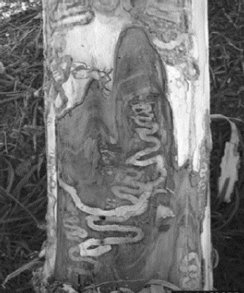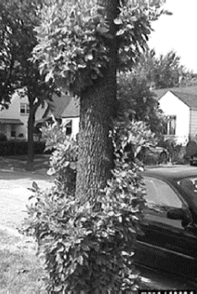by Hank Stelzer
Extension Forester
Landowners across the Show-Me State need to be
|
|
The emerald ash borer (Agrilus planipennis), or EAB,
|
|
The spread of this insect has been attributed to the movement of infected nursery stock and firewood logs. So far, emerald ash borer has only been found on green, white and black ash trees. The adults emerge from mid- May to late June and are a bright metallic emerald green (hence their name). Their length is about half the diameter of a penny. After mating, the females lay their eggs in bark crevices.
Larvae then feed in the phloem and outer sapwood, producing S-shaped galleries that eventually girdle and kill branches and entire trees. The larvae overwinter and the cycle begins anew the following spring.
Infestations of EAB can be difficult to detect until canopy dieback begins. Many trees appear to lose about 30 to 50 percent of their canopy in one year and the tree is often killed within 2-3 years of initial attack. Evidence of infestation include D-shaped exit holes on branches and trunk; vertical splits in the bark resulting from the tree producing callus in response to the galleries formed by the feeding larvae; heavy woodpecker activity as they feed on the larvae; and a profusion of bole and root sprouts. Systemic insecticide treatments of imidacloprid may or may not save infected trees, depending upon how long the tree has been under attack. The only proven control method is eradication of all ash trees greater than one inch in diameter surrounding the infected tree.
Sudden Oak Death
Sudden oak death, or SOD, burst
on to the national scene this
spring when it was reported that
two California nurseries that ship
woody ornamental plants all over
the United States had become
infected with the fungus responsible
for the disease.
Missouri was among the states receiving infected stock, but we were lucky. The suspect plants were traced and tested, and the results were negative. However, several southeastern states were not so fortunate. Statewide prevention efforts are currently underway at the Missouri Department of Agriculture, and on a national level, through the USDA to monitor the disease. Recent regulations require approximately 1,500 California nurseries to be inspected and certified free of the pathogen before nursery plants can be shipped.
  Left: Emerald ash borer larvae create S-shaped galleries that eventually girdle and kill branches and entire trees. Right: Trunk sprouts, or suckers, are a common response to emerald ash borer injury. These abundant sprouts may indicate the presense of the insect. |
|
|
Once infected, oaks display a list of symptoms, including cankers on the stem. Infected trees may survive for a couple of years, but once crown dieback begins, leaves turn from green to pale yellow to brown within a few weeks. Black or reddish ooze often bleeds from the cankers. Patches of blackened tissue are often found under the bark, and laboratory tests are needed to confirm the pathogen's presence.
There are several SOD look-alikes in the landscape. Oaks defoliated early in the growing season by insects or other pathogens may appear dead, but leaves usually reflush later in the season. Canker rots, slime flux, leaf scorch, root diseases, freeze damage, herbicide injury and other ailments may cause symptoms similar to SOD. The disease can also be confused with oak wilt, oak decline, and red oak borer damage; all prevalent pest problems in Missouri. As with EAB, to date there are no proven control measures for sudden oak death. If you suspect a tree is infected with the disease, contact your local Missouri Department of Conservation forester or extension specialist.
For more information on emerald ash borer or sudden oak death, contact Hank Stelzer at (573) 882-4444; or email stelzerh@missouri.edu. Information is also available at the USDA Animal and Plant Health Inspection Service web site at www.aphis.usda.gov.